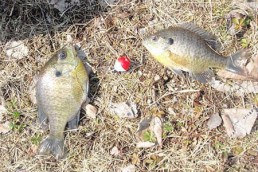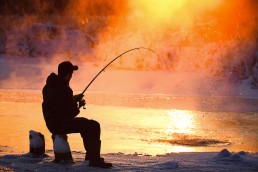Spillway Waters Provide Open-water Fishing Now
SHARE THIS POST
If you are not one of those who sit in a little shack, or worse yet, on a bucket out in the cold weather hovering over a little 6-inch hole in the ice waiting for the next panfish bite, here are three options—well actually one with three different locations—where you can stretch you muscles, make some casts and wind up with a pretty good mess of fish if you like action: Spillways.
I know that hardcore fishermen still fish the rivers, such as the Fox and Illinois, but a boat is needed most times for river fishing, and finding the fish can still be a problem. Think instead of fishing below the spillways at Lake Shelbyville, Carlyle and Rend lakes. These are large spillways with public access and the fish are coming to you. I do understand that in the wintertime the fish’s metabolism is slower, but they still do feed.
These spillways have fish in those rivers throughout the colder months, and slowly migrate upstream until they can go no farther—that end is at the foot of those spillways.
For species that you might catch, I have seen 20-pound-plus pure stripers come from the spillway at Rend Lake; I have seen 20-poound-plus muskies come from the spillway at Shelbyville. And, I have also seen 3- to 5-pound walleyes and saugers come from below the Carlyle Dam.
If that isn’t a good reason to give those locations a try, here are some others: Crappies, white bass, hybrid striped bass, well, there are so many (reasons) species of fish that inhabit the rivers that these spillways empty into that you can never know exactly what you might catch. I have seen catfish taken in these cooler wintertime spillway waters too. All or most river species congregate below these dams in these oxygenated waters, snacking at will on baitfish also congregating there.
Are you enjoying this post?
You can be among the first to get the latest info on where to go, what to use and how to use it!
The one thing that is practically a “must” is live bait.
I mentioned earlier that the fish’s metabolism at this time of the year is very slow, and though they will feed as they feel the “need” to, so to speak, most times they won’t muster up the speed and energy to chase a lure or a spoon very far. However, by drifting a large dangling nightcrawler or a small lively minnow on a small jig past their noses, you should get the desired affect. Sheer numbers of fish in those areas should guarantee you plenty of action.
In seasons when there has not been sufficient rainfall, those areas can sometimes be very low on water, but according to the U.S. Army Corps of Engineers, they are always fishable. With all the rain we’ve had that seems not to be a problem, but if you decide to make it a way of life for your winter-fishing endeavors, you can call ahead to the Corps of Engineers. They manage and are knowledgeable about flood control gates of those lakes, and will have the latest information. And, not only can they also tell you what the water conditions are, but with a little pleading, a little fishing information just might be available. Here are the numbers for the Corps at those sites: Shelbyville, 217-774-3951; at Carlyle Lake, 618-594-2484; and at Rend Lake, 618-724-2493.
Now last but not least, at the time I wrote this article I called all of those numbers to verify a few facts and low and behold the fishing was going strong at all three locations. Shelbyville and Rend lakes were producing nice numbers of fish, and at Carlyle Lake, those willing to get out and get their butts off that bucket are catching limits of saugers.
I think I’ll quit writing now and break out a few fishing rods; my freezer is getting thin on good, fish fillets.
MWO
SHARE THIS POST
Did you enjoy this post?
You can be among the first to get the latest info on where to go, what to use and how to use it!
Herman Kunz
Herman Kunz is a freelance writer specializing in all types of hunting, freshwater fishing and other outdoor-related activities, including seminar speaking and promotions. Kunz is on the field advisory staffs of Rapala, Flambeau tackle systems and Storm Lures, and may be reached at 618-599-2400.



